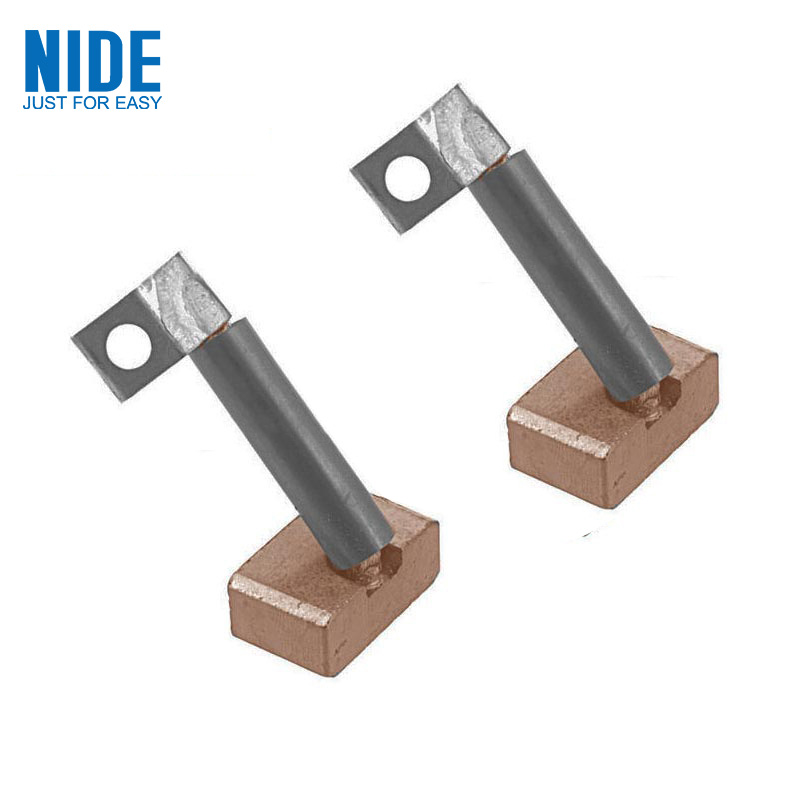Do You Know the Role and Characteristics of Carbon Brush for Dc Motor?
2025-06-20
In DC motors, carbon brushes (also called brushes) are key conductive components and have important responsibilities. What are the core features and functions of Carbon Brush For DC Motor?

A unity of conductivity and wear resistance: Carbon Brush For DC Motor is usually made of graphite or graphite composites mixed with metal powder (such as copper). Graphite provides key lubricity and a low friction coefficient to ensure controllable wear when in contact with the rotating commutator; while the added metal components (such as copper powder) significantly improve the conductivity to meet the needs of large current transmission. This combination of materials enables it to withstand continuous mechanical wear while conducting current.
Flexible elastic contact: The carbon brush is not rigidly fixed, but is gently and continuously pressed against the surface of the commutator by a constant pressure spring. This elastic contact mechanism is crucial, as it ensures that even when the commutator is irregular due to rotation or slight beating, a stable, low-resistance electrical connection can be maintained, minimizing contact resistance and sparks.
Positioning of wearing parts: Carbon brushes are consumables due to continuous friction with the high-speed rotating commutator. Their service life is affected by factors such as material quality, working current, motor speed, commutation, environment (such as dust, humidity, temperature) and spring pressure. The design should be easy to check and replace.
The bridge of power transmission is the most fundamental function of Carbon Brush For DC Motor. In a DC motor, the rotating armature (rotor) winding needs to obtain current from an external static power source to generate a magnetic field and torque. As a stationary component, the carbon brush is connected to a fixed power line at one end and slides in contact with the commutator segment fixed on the rotor shaft at the other end, continuously and reliably transmitting the power of the external DC power supply to the rotating rotor winding, providing energy input for the motor operation (motor mode), or transmitting the power generated by the rotor winding to the external load (generator mode).
A key link in achieving mechanical rectification (commutation): For a DC motor to rotate continuously, the direction of the current in the rotor winding must be periodically switched (commutated) at the moment it passes through the neutral line of the magnetic pole. The commutator segments rotate with the rotor, and different segments contact the fixed carbon brushes in turn, and automatically change the rotor winding circuit connected to the power supply (or load) in coordination with the position of the brushes. The carbon brush physically realizes the direction switching of the current in the rotating winding through orderly contact and separation with different segments of the commutator, that is, the mechanical rectification" process. This is the basis for the continuous operation of the DC motor.
Maintain a stable electrical connection: maintain close contact with the commutator through spring pressure, and maintain a low-resistance, low-loss electrical connection path even in the case of vibration or slight eccentricity, ensuring the efficiency of energy transmission.
Derivation of commutation sparks: At the moment of current commutation, due to the existence of coil inductance, tiny sparks (commutation sparks) will inevitably be generated. Well-designed carbon brushes have a certain arc extinguishing ability (graphite itself also has a certain role), and help release this part of energy through a good conduction path, reducing the damage of sparks to the commutator and winding
insulation.
Carbon Brush For DC Motor is an indispensable conductive bridge between the stationary circuit and the rotating circuit in the DC motor. It is responsible for the efficient transmission of electrical energy and is also the physical executor of the core function of automatically switching the direction of the rotor current (commutation). Its special material composition (conductive + wear-resistant) and elastic crimping method ensure relatively stable and reliable operation in harsh sliding friction environments. However, it is precisely because of this continuous friction that it becomes a key wearing part that requires regular maintenance and replacement, which has a direct impact on the performance and life of the motor. Regular inspection and replacement of carbon brushes that are worn to the limit is an important part of maintaining the normal operation of the DC motor.

